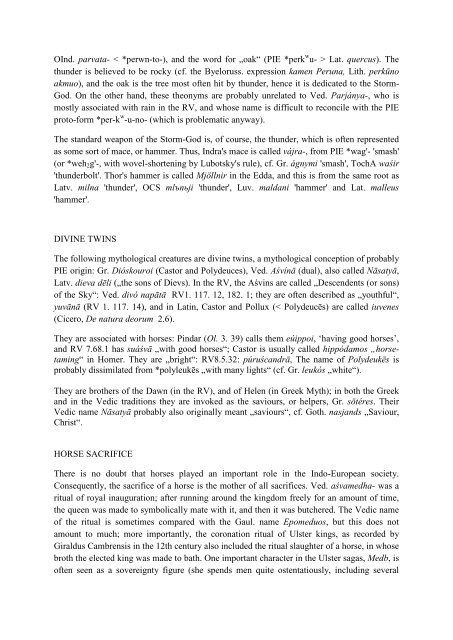A READER IN COMPARATIVE INDO-EUROPEAN MYTHOLOGY
A READER IN COMPARATIVE INDO-EUROPEAN MYTHOLOGY
A READER IN COMPARATIVE INDO-EUROPEAN MYTHOLOGY
Create successful ePaper yourself
Turn your PDF publications into a flip-book with our unique Google optimized e-Paper software.
OInd. parvata- < *perwn-to-), and the word for „oak“ (PIE *perk w u- > Lat. quercus). The<br />
thunder is believed to be rocky (cf. the Byeloruss. expression kamen Peruna, Lith. perkūno<br />
akmuo), and the oak is the tree most often hit by thunder, hence it is dedicated to the Storm-<br />
God. On the other hand, these theonyms are probably unrelated to Ved. Parjánya-, who is<br />
mostly associated with rain in the RV, and whose name is difficult to reconcile with the PIE<br />
proto-form *per-k w -u-no- (which is problematic anyway).<br />
The standard weapon of the Storm-God is, of course, the thunder, which is often represented<br />
as some sort of mace, or hammer. Thus, Indra's mace is called vájra-, from PIE *wag'- 'smash'<br />
(or *weh2g'-, with wovel-shortening by Lubotsky's rule), cf. Gr. ágnymi 'smash', TochA waśir<br />
'thunderbolt'. Thor's hammer is called Mjöllnir in the Edda, and this is from the same root as<br />
Latv. milna 'thunder', OCS mlъnьji 'thunder', Luv. maldani 'hammer' and Lat. malleus<br />
'hammer'.<br />
DIV<strong>IN</strong>E TW<strong>IN</strong>S<br />
The following mythological creatures are divine twins, a mythological conception of probably<br />
PIE origin: Gr. Dióskouroi (Castor and Polydeuces), Ved. Aśvínā (dual), also called Nāsatyā,<br />
Latv. dieva dēli („the sons of Dievs). In the RV, the Aśvins are called „Descendents (or sons)<br />
of the Sky“: Ved. divó napātā RV1. 117. 12, 182. 1; they are often described as „youthful“,<br />
yuvānā (RV 1. 117. 14), and in Latin, Castor and Pollux (< Polydeucēs) are called iuvenes<br />
(Cicero, De natura deorum 2.6).<br />
They are associated with horses: Pindar (Ol. 3. 39) calls them eúippoi, ‘having good horses’,<br />
and RV 7.68.1 has suáśvā „with good horses“; Castor is usually called hippódamos „horsetaming“<br />
in Homer. They are „bright“: RV8.5.32: púruścandrā, The name of Polydeukēs is<br />
probably dissimilated from *polyleukēs „with many lights“ (cf. Gr. leukós „white“).<br />
They are brothers of the Dawn (in the RV), and of Helen (in Greek Myth); in both the Greek<br />
and in the Vedic traditions they are invoked as the saviours, or helpers, Gr. sōtéres. Their<br />
Vedic name Nāsatyā probably also originally meant „saviours“, cf. Goth. nasjands „Saviour,<br />
Christ“.<br />
HORSE SACRIFICE<br />
There is no doubt that horses played an important role in the Indo-European society.<br />
Consequently, the sacrifice of a horse is the mother of all sacrifices. Ved. aśvamedha- was a<br />
ritual of royal inauguration; after running around the kingdom freely for an amount of time,<br />
the queen was made to symbolically mate with it, and then it was butchered. The Vedic name<br />
of the ritual is sometimes compared with the Gaul. name Epomeduos, but this does not<br />
amount to much; more importantly, the coronation ritual of Ulster kings, as recorded by<br />
Giraldus Cambrensis in the 12th century also included the ritual slaughter of a horse, in whose<br />
broth the elected king was made to bath. One important character in the Ulster sagas, Medb, is<br />
often seen as a sovereignty figure (she spends men quite ostentatiously, including several



